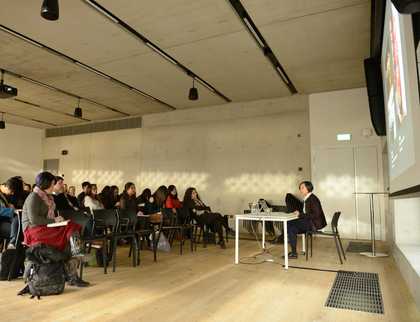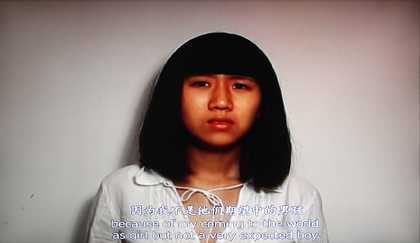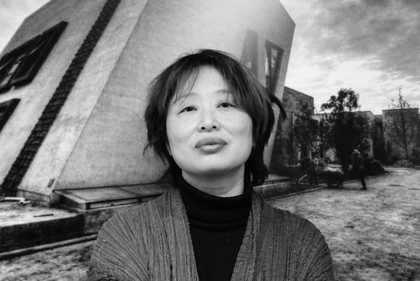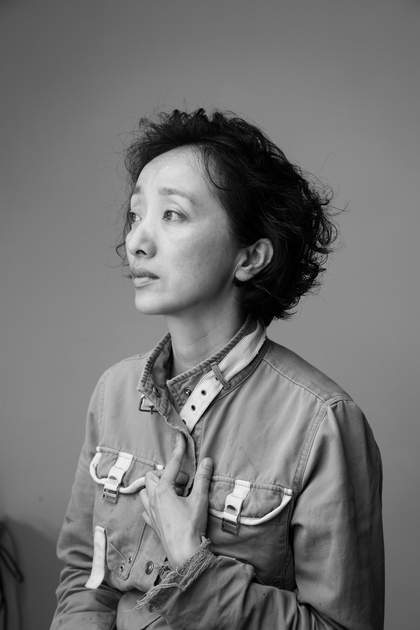
Xiang Jing
Photo: Fan Xi
Image courtesy of the artist
Monica Merlin: How has the situation for women artists changed since the 1990s?
Xiang Jing: If you want me to look at it in terms of gender – to divide people into male and female artists – I am not used to seeing things this way and my reaction time would be pretty slow. First of all, I did not pay attention to this group of so-called female artists. I did take part in exhibitions organised by people like Jia Fangzhou, which featured only female artists, but I really did not pay much attention when China began to have female artists. It was only when I made more work, and increasingly became labelled a ‘female’ artist, that I came to realise that I also count as a woman artist.
In China, the concept of feminism was imported from the West. Western feminism has its own practices, theories and texts. It comes out of some spontaneous feminist movements and incidents in the West, with numerous books and theories supporting their validity. But I am not too sure that feminism is suitable or relevant to Chinese culture, because China has never had a conscious awakening or any so-called female liberation movement initiated by Chinese women themselves.
Around the time of the May Fourth Movement or even earlier, there were a small number of these feminist movements, started by women who had studied abroad and who fought for equal employment rights and working conditions. But after 1949 I think that the situation of Chinese women became quite strange. Chinese women had more or less been liberated because Chairman Mao said, ‘Times have changed, and men and women are the same’; suddenly women became the same as men, and they needed to go out to work. My parents’ generation are all like that. I think there was gender equality back then because there was not enough manpower – perhaps the Communist Party thought: ‘Everyone should go to work. If women join in, we can build and develop this country much faster.’ Yet I think that this change in women’s job opportunities was not earned by women themselves. It was Mao who liberated women by saying ‘Women can hold up half the sky’. At that time, in the countryside, there was a point system – if you worked for one day then you would earn a certain number of points. The points meant money, so you would have food to eat. The conditions were the same for everybody – women and men both went to work to earn these points.
So I think that the rights and conditions that Chinese women have gained are entirely different from those of Western women who fought for themselves. In our culture, the situation is more complex – on the one hand, women enjoy the conditions or opportunities that other people fought for, but on the other hand, the values that we subscribe to still discriminate against women. It is not only men who believe in those values: I think that actually the majority of women also subscribe to the same values. For example, normally women feel that they can gain a greater sense of self-worth by making sacrifices for their families and their children. I think it is connected to our deeply ingrained education system.
We talked about the so-called ‘disappearance of female artists’ – I think this is a very interesting concept. Why do so many women artists disappear? To my knowledge, most of them disappear because they choose to do so. They have a child, and they probably do not want to practice art any more, or they work less. In fact it happens to a lot of interesting and talented female artists. It really is simply because they have had a child. They consider it very hard for them to come back to the professional world and the art circle. Perhaps in their families they have found their place or a sense of belonging.
So the situation is quite complicated. Women artists are not forced into giving up their careers. Of course Chinese culture is a patriarchal one. It has always centred on men and marginalised women. But I think looking at the overall picture, many women have a high regard for this value system.
Not everyone agrees with the system, but most women do. Only by knowing this complexity can you understand the situation of Chinese women and Chinese women artists. For example, Yu Hong and Jiang Jie, two of my close friends, both have sacrificed a lot for their families, to a degree that no one can imagine. Yu Hong did close nothing for many years except bringing up her child. Very often, women give all they have to their families. Men carry on with what they do as usual, whereas women give up all they have. For their children, they sacrifice anything including working and painting. She might still have a job as a teacher, but she has given up her career as an artist. Jiang Jie is the same. I believe if not for child rearing, she would have made more art and become more successful.
The only reason I can make so much art is that I do not have a child. That is what I gave up. I traded the time I might have spent on a child or family for the time to make art. An artist must keep working continuously in order to grow, to progress and to think well. That is how it works. I did not choose to do it this way consciously – there were many accidental factors as well. I was not determined from the beginning to be an excellent female artist and not to have kids. It was not like that at all. I once longed for a child. I wanted to be a good wife and a good mother. It was fate that gradually brought me to where I am, rather than me strongly resisting something. It was not my choice, really.
Most of the women I know well put their families, their husbands and their children before their careers. I can always feel that. When we hang out, we often talk about children. They often say, ‘Oh, I need to leave early and go back to my child at home’. They rarely have a chance to go out, but when they do they are always in a hurry to go back to their children. Sometimes, I am secretly smug that I do not have a child. Of course, you cannot pre-plan your life: I happen to be living this life without choosing it. They happen to live the other kind of life. I cannot compare the two and decide which is better. I think this is an enormous obstacle for female artists in China.
Why there are so few female artists? Honestly, I think that really good female artists are very rare. I do not think the reason is that women do not get enough opportunities, rather, I think it is because women artists are genuinely not good enough or the good ones are rare. Just as you said, those who have an impact on art history are few. I think that this is caused by the aforementioned reasons. A Chinese woman does not tend to consciously think that being herself or realising her self-worth is the most important thing. She always sees herself in relation to her family, and considers that as the most important thing. I do not want to judge if that is right or wrong, good or bad, but this seems true to many women that I know. I think it is the reason that we do not have enough female artists, or enough good female artists. In a nutshell, this is the cause. I do not know if this is easy to understand, given that there is a cultural difference.
The younger generation of artists face a wider range of situations. They live all kinds of lives, so their art is much more diverse. Society now is more open, and we have more Western influences. Those kids are born to be different from our generation – they think differently. For instance, in my generation, there were hardly any lesbian artists. But in the younger generation, there are many of them and they live the way they want.
You must know about Karen Smith. She once interviewed me, and asked me a question that surprised me very much: ‘Why are all Chinese female artists good-looking?’ I had never thought about it and I was surprised. My reaction was, ‘Does it have anything to do with art?’ She just asked it and I couldn’t answer it at all, because it had never crossed my mind. I just said, ‘Really? I know nothing about it.’ She might have been joking and just asking a humorous question. She did not include this question in her book. The two of us were just casually chatting before the interview and that question remained unanswered. So that episode just passed, but it stayed in my mind.
Maybe Karen did not mean every Chinese female artist is good-looking. Maybe she was referring to the male-dominated art circle and the unavoidable male perspective. In China, there are very few female artists and even fewer female curators. Women are rarely in positions such as directors of art museums. They are more likely to be employees at art galleries. There are very few female curators in influential positions. This is common in the art world. I wonder whether that is what she implied.
Monica Merlin: Do you think this situation you just described is related to the traditional social system?
Xiang Jing: Yes. Frankly, I did not realise this from the outset. I slowly came to the realisation, very slowly, when I was nearly forty years old. Throughout my thirties, I had been slowly digesting the issue and thinking about it. That is what inspired me to make works with women’s nude bodies. I was thinking about women’s own problems from a female point of view. Before, I would not have thought about it, but after being asked related questions for so many times, I started reflecting upon it and then made those works.
Monica Merlin: I think when you first started making nude sculptures, you were probably the first woman artist in China who did it. I wonder if that crossed your mind. Few women artists made art depicting full female nudity before you.
Xiang Jing: It is interesting, when I made those works, it was a big change in direction for me. Many people asked, ‘why do you make things like that?’ A few men even said that I was very immoral. Actually on my part, I was not strongly challenging anything, not at all. However, other people’s reactions to the piece made me realise that it posed a challenge to established values. I heard people call my works ugly or horrible, especially the piece Your Body. I got all sorts of comments. Those pieces were in my studio for a summer – actually for an entire year – without anyone inviting me to exhibit them. Later I organised a solo exhibition myself – the audience found them scary. Or to phrase it more gently, those works make people feel uncomfortable.
Provoked by other people’s reactions, I started thinking more about those works. My concept behind those works was to depict bodies that are not being gazed upon by others, bodies that exist as they are for themselves. It is about the self. That is what I wanted to do. I wanted the bodies to open themselves up, without covering anything up. They are also normal bodies, not beautiful or idealised. So I did not intend to confront anything, but just wanted to do something about the self. However, even doing just that turned out to be very challenging – a lot of people felt wounded and uncomfortable, they said ‘how can you do this? It is horrible!’ I was thinking why people had that kind of reaction. I only understood this with hindsight. I did it without intention, and just let it come into being instinctively. I did not intend to challenge anything before I made that work, but nevertheless that was the effect. The whole situation made me think – why? I just wanted to make something genuine, how come it gave people such a shock? Do real women look so hideous?
Monica Merlin: When you made the works, did you feel that women’s bodies were ugly?
Xiang Jing: Not at all. In my art creation, I do not draw a line between so-called ‘ugliness’ and ‘beauty’. I believe all my art is ‘beautiful’, if we must use the word.
Monica Merlin: They are different from the typical models you usually see.
Xiang Jing: Of course, they are also different from the traditional beauties. They are about women’s subjectivity. Women are often ‘she/her’, never ‘I/me’. There has not been any narration about women from an ‘I/me’ perspective. Women have always existed in the role of ‘she/her’. Once a woman appears as ‘I/me’, people are not used to it. That is my understanding after making those works. It immediately became clear to me that this was what I wanted to do. That was what my exhibition was about – I explored all kinds of issues a person might face in life from a woman’s perspective.
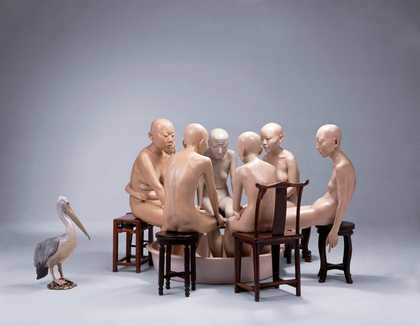
Xiang Jing
Are One Hundred Playing You? Or Only One? 2007
Image courtesy of the artist

Xiang Jing
The Open 2006
Image courtesy of the artist
I made progress over time. When I made those earlier works, the sense of confrontation was too strong. In my later works, I emphasised an individual’s situation, how their existence met their own needs, and their subjectivity. That was how some of my works were conceived, for example, the ‘feet bathing’ series Are One Hundred Playing You? Or Only One? 2007 and the girl who does yoga, I am 22 Years Old, But Without My Period 2007. I do not think they deal with concepts of gender politics, but of course people can easily think of gender politics when seeing these works. People sense conflict as they assume that you have a position and want to challenge it by adopting the opposing view but I think I made progress in these works because I did not set up an opposing view. I was only observing the phenomenon.
I think that these works go past the subject of gender. It is not about gender. To me, the most important task, work or point of interest is human nature. I use female bodies as a vessel, subject matter, or medium to express myself, but the issues I am discussing are about people, not just women. This is my biggest achievement or progress through these works. I no longer have the gender opposition between male and female in mind. I am making less restrictive work.
Monica Merlin: Can you talk a bit more about people’s reaction to these works in the beginning?
Xiang Jing: For me, the exhibition Naked Beyond Skin 2008 was very successful. Making art and exhibiting art are two different things. I used to focus on making art and did not have much experience in exhibiting. When I did it, it felt like a great leap to me. This exhibition was very complete, and it was entirely about women’s bodies. Everything was there, including the large Buddha-like piece The Open 2006, the feet-bathing piece Are One Hundred Playing You? Or Only One? and several other pieces. They formed a complete exhibition.
Because those works did not contain a sense of conflict, the exhibition felt tranquil. The significance of tranquillity to me is similar to immanence, to use a philosophical term. Immanence is the truth of human existence. Our outward forms and our social attributes are only the surface layer, whereas immanence is the truth. It is truer than reality. This exhibition celebrates immanence. When you come into the exhibition space, you felt like you entered your inner world. It was like the inner world was manifesting itself before you. So I think that in this exhibition, you could calm down, and look at the works slowly. The representation was very meticulous and complicated, such as that of the feet-bathing piece. It is hard to describe it with words, but you can feel there is so much content in it, and so much that could be said.
This is the state I want to bring people into – I want them to enter into their own inner self. Regardless what contemporary art is, in my heart this is the most important thing that art can do. Of course, I liked this exhibition very much and I feel that maybe because the display of the show was very clear and easy for people to understand, it received many positive comments about the quality of the exhibition.
Monica Merlin: You said that these works are capable of inspiring discussion on many subjects, some of which I have thought about myself. For example, the relationship between people and their bodies. You mentioned that immanence is the most important. You also talked about the point of view from which we see ourselves and the world that we live in. These are all related to our bodies. In your sculptures, I can see different skins as well as different emotions. You can tell that the figures live different lives under different circumstances. Could you talk about the relationship between people and their bodies, or the importance of security in your works?
Xiang Jing: My works are often regarded as realistic. Many people think that my works look real and they think that I am interested in ‘reality’. But I am not. My work does not comment directly on reality or social issues. Bodies are the vessel. We must exist through this exterior vessel. However, in my opinion – I do not know about other people’s – the only way to prove that we are alive is to make an effort to understand our internal world.
When I made this series, the idea came from some lyrics by a Chinese rock star, Cui Jian: ‘It is a shock your body gives to your rotting soul.’ It means our bodies can wake up our numb and hidden souls. I think the ‘shock’ here is a reminder of your existence. My interpretation is that it’s about how important your soul is. You need to wake it up, give it a shock and let it reveal itself again.
- see so many changes these days and the changes are so rapid and incomprehensible. They happen in the external world. Things can look one way on one day and totally different the next day. Your house may be demolished one day. You may suddenly realise that the water you drink is poisonous, or you may suddenly find out that your friend has had plastic surgery and looks different now. Every day you encounter all kinds of changes. In such a rapidly changing society where a sense of security is lacking, what can give us comfort? What will never change? Perhaps this is the essence of the question that I am asking.
Monica Merlin: Looking at your works, ageing bodies could be another subject.
Xiang Jing: I have not depicted a really aged body. In a way, I am obsessed with aesthetics. I am getting better now though. It is a kind of growing up. It used to be hard for me to face ugliness. Everything had to be beautiful. Now I have come to accept many things, even an aged body. When it is only a rotting and disappearing body, it is very frightening and ugly to me. But when I can see dignity and the inner life in it, I am able to find it beautiful. One day, when I finally come to a real understanding of this, it will be something I want to make art about.
Monica Merlin: When I grew up, I spent a lot time with other women – at home, in school and on other occasions. In this series, you often depict women together, such as in Are One Hundred Playing You? Or Only One?. Are you exploring the relationships between women?
Xiang Jing: Actually, reality isn’t very important to me. In other words, my works do not come from reality. In any culture, it is unlikely that a group of people would get naked together and bathe their feet. But it is possible in a person’s heart. Human beings cannot be deprived of their social nature – we always live in groups. It is hard to live alone and far away from others. You must have social relationships, otherwise you would feel frightened. I think this piece is about a kind of warm relationship in which people give comfort to one another.
Very often I make work about women because this kind of relationship is quite common among women – by which I mean, a physically intimate one. It is easier for women to hug each other. Particularly in Chinese culture, it is normal for women to stroll down the street hand-in-hand or arm-in-arm. This is normal and natural. I was teaching in a university in Shanghai. It was spring and flowers were blossoming in the park. Every day I saw different flowers blossom. When there was a breeze, the blossoms fell from the trees, scattering petals everywhere. I felt that was very pretty, so I invited some female students that I was friendly with and asked them to bring a few girls to take some photos. Some girls were acquaintances, some were not. In the park, I was standing far away from them, taking photos with my camera. They got to know each other quickly – it is so easy for women to get to know each other. They soon got to enjoy themselves and became completely unaware of me. When they were tired, they rested together and hugged each other. This relationship or affection between human beings is beautiful. Maybe we cannot understand each other, but we can give each other warmth. I think the origin of these pieces might have been related to this experience.
Monica Merlin: The questions I asked are not necessarily related to reality, but looking at the sculptures I feel they are related to society and our lives. For example, The Center of Quietude. When I looked at it, I could see myself as the sculpture. The perspective from which you see your own body when growing up is important. Is the work about the relationship between a woman and her body or sexualisation?
Xiang Jing: In this society, women’s position is either completely marginalised or objectified. Their bodies are always being watched. Maybe the situation is better in the West, or maybe it is similar there. In today’s consumerist culture, women’s bodies are prone to becoming objects of consumption. People want to have beautiful bodies, or rather bodies that measure up to aesthetic standards, but actually every kind of body exists. In the end, you may have to face all kinds of bodies that do not meet those standards, including your own body. Many people discover their self as they discover their unique bodies. It is only women who have the problem of trying to meet one single standard.
Monica Merlin: I agree, and it puts pressure on women. Not meeting the standard is painful to many women and many may change their personalities or bodies in order to fit in. I think this is a major issue in today’s society. I wonder whether you thought about this issue when you made these sculptures?
Xiang Jing: Of course, but it was not my main concern.
Monica Merlin: Perhaps your works can be viewed from various perspectives.
Xiang Jing: Yes, and in that sense it does concern the issue of the standards women are subjected to. For example, this sculpture is an interesting piece because while the girl is pretty – her face is that of a young girl – her breasts look like big sacks. Recently I went to do an exhibition in Hong Kong and I brought four pieces like this one. During a seminar there, a girl said that in my works bodies are often mixed together, for instance, a child’s face mixed with an old person’s body. She asked whether that was how this piece was made. I replied saying that she had asked the question as if she was not a woman. Did she know that women’s bodies vary? It is not only old women who have sagging breasts. A lot of people may not believe it, but some people naturally have breasts like that. They are young, maybe in their twenties, but their breasts look like that because they are too big. I said, ‘Don’t you know that? You asked the question like a man.’ I made these works because women’s bodies vary. All shapes are beautiful in my eyes. They exist. Their existence is meaningful and valuable, and they are very beautiful.
Monica Merlin: And they are not afraid of being naked!
Xiang Jing: Exactly. We need to face it just like we need to face ourselves. We need to accept it just like we need to accept ourselves.
Monica Merlin: My final question is about the Mortals (Acrobatics) and Otherworld (Animals) series.
Xiang Jing: I made these two series in 2011, after the Naked Beyond Skin series. I thought that I wanted to stop making work about female bodies so that people would stop calling me a feminist artist. I felt bored. I had had enough.
Monica Merlin: Looking at these works, however, I can sense positivity in the works’ idealism and optimism.
Xiang Jing: Do you feel that?
Monica Merlin: Yes, but I am not sure, so I would like to ask you. Can you talk about these two series? They seem to uncover some big issues.
Xiang Jing: Yes, big issues. You cannot find answers to these issues in the artworks. That is impossible. If there is an eternal subject matter for me, it is human nature. These works are about chujing, the predicaments we face. I do not know what the neutral, equivalent word in English would be. It is not situation. It is not plight either because that has negative connotations. The title of the exhibition Will Things Ever Get Better? is a question for the future. It is a question about people’s fate, and fate is related to now. It has something to do with the sense of security that I mentioned. We need to think about how we face the circumstances that we are in, and how we reflect on such circumstances. Then we can gain a grasp on our fate in the future.
Monica Merlin: So, what do you think about the future?
Xiang Jing: It is impossible to answer this question. Interestingly, during my solo exhibition at Today Art Museum in Beijing in 2011, I sent the question to many people, people I know and do not know. I got all kinds of answers. The last stop of the exhibition tour was at the Museum of Contemporary Art in Taipei in 2013. The museum placed a notebook at the exhibition and invited visitors to write in it answering the question. Over ten notebooks were used. People wrote in Chinese, English, French, all kinds of languages. Other people drew. There were all sorts of answers. Some people wrote a lot using very long paragraphs. It was very interesting.
Monica Merlin: What would your answer be?
Xiang Jing: My works are the answer. The significance of the question is to remind us to reflect on ourselves and think about what we should do now. What we do now is connected and related to the future. This is my concern – what we are doing now, what our predicaments are now. Mortals (Acrobatics) explores the roles that we play in society.
Monica Merlin: But when I see these works, they deliver a sense of idealism. The women’s bodies look healthy, they seem capable and they are performing well. One is smiling happily.
Xiang Jing: Do you not feel that you have to appear capable and happy when you work? In the beginning, it was just a concept but I increasingly feel that it is very similar to how we must follow social roles. Otherwise, we will suffer depression or get sick.
Monica Merlin: So it is nothing to do with ideals.
Xiang Jing: No. It is about our roles – the roles that we must play well and cannot afford to fail at. As the two of us chat, I do not see any problems with you and you do not see any problems with me either. But, in fact, we both might have many problems; I have problems.
Monica Merlin: That is true. But does your series also have something to do with traditional Chinese art?
Xiang Jing: That is another subject matter I want to work on. I did not do it in this exhibition, but I am interested. I already did some tests with some transparent materials. I want to do something about Oriental aesthetics. It is something that I really like.
Monica Merlin: Going back to what you said earlier about our performance in society, I can see how these works deal with the paradox of reality.
Xiang Jing: Yes, the paradox of reality. The Otherworld (Animals) series represents the opposite, as animals live in a more natural state than the one we are in.
Merlin Merlin interviewed Xiang Jing in her Songzhuang Studio, Beijing in November 2013.

